These stories document Mexico’s black market hunger for American guns. The hidden cross-border trade is hardly a new phenomenon and for decades has occupied a back burner in the national policies of both countries. But with Mexico’s drug war body count surpassing 6,000 in a single year, 2008, a figure that almost flatters the number of American dead in Iraq, the weapons smuggling issue has been suddenly thrust to the top of Mexico’s policy agenda. That reality holds important implications for American taxpayers and legislators as Mexico presses the U.S. for action. While drugs flow north, much to American consternation, American guns are in turn flowing south, powering a literal civil war pitting Mexican drug syndicates against one another and the state. To bring clarity to this gathering foreign policy issue, Express-News reporter Todd Bensman, with photographer Jerry Lara, traveled extensively on both sides of the Texas-Mexico border. Bensman examined hundreds of court records, and interviewed federal police, diplomats and government officials in Mexico and the U.S. He interviewed a former cartel assassin, gun store owners and convicted felons in the trade. And he traveled deep into Mexico to record the human impact behind the body count statistics that American guns have wrought.
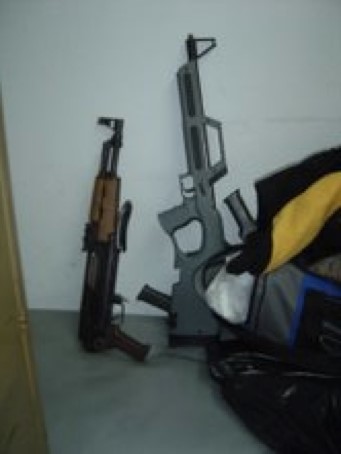
AGUASCALIENTES, Mexico — In the vivid dreams that now comfort 17-year-old Angelica Navarro Calderon, her father often comes to visit, dressed in his police uniform. The bullet hole between his eyes has vanished. Nine other bullet wounds in his chest, arms, leg and back are healing beneath white bandages. Father and daughter banter about life, just like they did before narcotics traffickers killed him and three other police officers at noon on a busy street last year on a day now known as “Black Thursday.” She recounted her dreams in the cluttered three-room family home, where a photo of José Juan Navarro Rincón adorns a living room wall and his desk. He looks military proud under his service cap.
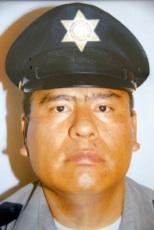
I dream that he is planning my birthday parties once again, and that we are all together talking again,” Angélica, one of his three children, said through an interpreter. “In that dream, my father is making my mother laugh. He told me to watch over her. And then he said, ‘It doesn’t matter, it was my turn.’.”
Angélica’s father had worn a police badge for 23 years in this Central Mexico state capital, rising to subcommandante and, at 40, was nearing retirement. The hail of bullets came so fast neither he nor his fellow officers had time to fire a shot.
Even if they had, their old .38 caliber revolvers would have been no match for some of the weapons that the cartel gunmen wielded that day: body armor-penetrating assault rifles and semi-automatic pistols.
It turns out that some of the weapons found where the four policemen were killed, including a Walther G22 assault style rifle and a Beretta M9 semi-automatic handgun, began their 475-mile journey from a cramped private gun store overlooking the Rio Grande in Laredo, Texas.
It’s against the law to own or sell such guns under Mexico’s strict regulations, but as cartels on the warpath know, they are readily, abundantly and legally available at the Main Street sporting goods stores and gun shows of the United States.
Texas is the cartels’ primary source for the tools of their trade because of the state’s abundance of retailers, proximity to Mexico and a cultural affinity for firearms that make them household items.
The cash-rich cartels pay handsomely for “straw buyers”— people with a clean criminal record who can easily skirt gun laws without suspicion — to acquire the lethal firepower from licensed retailers, gun shows and private sellers, sometimes leaving no paper trail before handing them over to killers.
The story of how some of the Laredo-purchased guns ended up in the hands of Aguascalientes drug enforcers on black Thursday illuminates how undemanding U.S. gun laws, ample drug money and cunning cartel procurement tactics feeds a drug underworld insatiable for firepower.
The southward passage of the Laredo guns also illustrates how law enforcement agencies now ramping up a new border-wide supply line crackdown with Mexico might be hamstrung to stop the flow in coming years.
Gun smuggling to Mexico is nothing new; it dates back to the late 1960s when a Mexican government dealing with student radicals enacted severe gun ownership restrictions. But the violence now plaguing the government of President Felipe Calderon’s federal, state and local police has propelled the issue to the very top of the country’s foreign and domestic agenda. Recently, after much pressure and sometimes bombastic Mexican statements, the idea has caught on with the Americans who have ramped up joint operations.
Texas, for obvious reasons, is a focal point for much of the new law enforcement and intelligence activity.
Last year, Texas sellers were the source of 1,131 guns found discarded at shootings in Mexico or confiscated from the cartel gangsters, according to the U.S. Bureau of Alcohol, Tobacco, Firearms and Explosives. That’s more than twice the number of runner-up California and more than the combined total of 13 top other states. An untold number of guns couldn’t be traced or are still hidden in Mexico waiting to claim the next victim.
The cartels discriminate when it comes to weapons. Generally, the more lethal, the more desired. They’re willing to pay more than double the retail price. Some of the hardware is military grade — rocket launchers and grenades coming into Mexico through Guatemala.
But most of the armaments is coming from America. Some of the assault-style rifles preferred by the narcos are so pernicious that, if modified to fully automatic as they often are, they can fire 10 rounds a second with a force that can rip through most standard armored police vests. They are so prized that they command double the usual U.S. retail price. And they are so prevalent these days that Mexico authorities have seized 13,000 of them in the last two years, along with thousands of other guns and 3 million rounds of smuggled ammunition, much of it also bought from U.S. retailers.
Illegal arms have been used to kill more than 4,000 people in Mexico this year alone, a huge spike. When President Felipe Calderón declared war on the narcos two years ago, the cartels, already battling among themselves, answered with violence against police and military personnel. Since then, 600 Mexican police and soldiers have died in the line of duty, and the blood thirst for weapons has grown as the cartels expand their private armies.
Under intense pressure from the Calderón government, the U.S. has only recently begun to commit more people and resources to catch gunrunners and work in tandem with Mexico.
“If you’ve got a neighbor who’s got a dam behind his house and it’s starting to leak, it doesn’t do much good to wait until it breaks to go fix it,” said J. Dewey Webb, head of the Houston office of the ATF that oversees much of the Texas border. “We have a responsibility to help him before that happens. The Justice Department has made this one of (its) top priorities.”
Senior Mexican law enforcement officials and diplomats said the Calderón government plans to press President-elect Barack Obama’s transition staff to make gun smuggling a continued law enforcement priority and develop new legislation in the Democratic-controlled Congress that would make it easier to track weapons sales to the smugglers.
“This is a critically important challenge for Mexico, Mexico’s security and Mexico’s ability to roll back and shut down some of the drug syndicates,” said Mexico’s ambassador to the U.S., Arturo Sarukhan. “We have a responsibility to stop drugs moving into the U.S., but the U.S. has a responsibility to stop the flow of weapons moving into Mexico.”
Against the backdrop of a developing partnership on the gunrunning problem, the Aguascalientes murders triggered a doomed trafficking investigation on Texas soil.
Elusive leads
An armored Suburban carrying several cartel gunmen, along with cash, weapons and bulletproof vests, somehow rolled over in downtown Aguascalientes on Feb. 15, 2007. Rincón and his fellow municipal police officers, Juan Rivera Molina, Eduardo Flores and Genaro Salas Sandoval, responded in time to arrest the men offloading their illegal belongings into another Suburban that had arrived.
Moments later, according to police, cartel fighters drove up in a third Suburban and staged a rescue. Holding the officers at gunpoint, they freed their men and equipment. Then they sprayed the officers with machine guns and at least one pistol, wounding several other officers and bystanders.
Today, crosses erected by the men’s families mark the otherwise banal spot where it happened. The killings signaled the arrival in Aguascalientes of warring drug gangs, a scourge that had somehow bypassed it and now won’t depart.

María Elena Ortiz Gaitán, the 36-year-old widow of Juan Rivera Molina, raises the couple’s children, ages 5 to 16, alone. One recent evening in the family’s spartan home, María gathered around the kitchen table with her children to look through the items removed from her husband’s pockets: bloodstained pay stubs and an identification card partly clipped by one of the dozen bullets that killed him.
For a long time she could not cry. To get through life she imagines her husband of 17 years is working in the U.S. as he did in the years before he became a police officer.
María, a secretary at a health clinic, maintains a steely demeanor; she said she must be strong for the children. It hasn’t been working though. Recently, her daughter’s kindergarten teacher called to report the 5-year-old announced she would commit suicide so she could hug her father again. Other kids had offered to help.
She sat the girl down and explained that “God gave us life and we need to stay here,” María said as her daughter stood beside her clasping her father’s photo. “Her father would be very sad if she continued saying such things.”

Asked how she feels about the guns coming from the U.S., María was resigned. Even if the ones that killed her husband had been stopped at the border, she said, “Other guns would have been smuggled in, and he would have died anyway.”
Maybe so. But both governments act as though they mean business.
The body count in Mexico — and appeals for American help — has finally had an effect. The ATF is expanding its program in Mexico to trace the paths of more guns from the U.S. and is sending more agents southward.
They and other security agencies like the FBI and Immigration and Customs Enforcement have launched border-city programs with names like “Operation Gunrunner” and “Armas Cruzadas” to hunt for straw buyers.
Gun show sellers and store retailers report a noticeable increase in ATF visits in the last year. Involved law enforcement officials admit it will be tough to make even a small dent.
“It’s a difficult task, but it can be done,” said Webb, the ATF’s Houston division head. “Will we ever stop it to zero? No. But we can make it to where it’s difficult for the cartels to get the tools of their trade.”
After Black Thursday, the ATF got word of a promising break: Mexican authorities were able to capture the suspects and turn over the serial numbers from some of the guns to ATF agents in Laredo, who hoped information from the suspect interrogations would later aid their trafficking investigation. A week after the shootings, ATF agents had followed the serial numbers to Universal Sporting Goods in Laredo, looking for the smugglers’ trail.
Points of origin
The tiny shop, between crumbling one-story buildings along Water Street, is two blocks from the river and one of the closest in the country to Mexico.
It’s so close, in fact that had owner Hart Raesch stepped outside his shop door a couple of years ago he could have easily heard the daily crackle and explosions from open warfare that devastated Nuevo Laredo.
Raesch, a tall, gray-eyed immigrant who still sports a German accent, has made a decent living from the store for 19 years. A wide assortment of rifles, among them a half-dozen AR-15-style assault rifles, lined one wall. A tag on one said it was reserved for “Tony the Tiger.” Ammunition boxes lined lower cabinets, and new handguns beckoned in glass cases.
ATF visits are nothing new to Raesch, especially in the last few years, so he knew the drill.
Raesch handed over receipts that showed the buyer of a Beretta M9, Fabrique National PS90 assault rifle and Walther G22 was a 28-year-old Laredo resident named Raúl Alvarez Jr. The buyer had put the guns on layaway six months earlier. Raesch told the agent that Alvarez had recently returned with cash and took the guns away.
Selling assault-style firearms has been legal since Congress let the ban expire in 2004 under pressure from gun lobbyists.
The law requires only that dealers run an instant FBI background check to make sure a buyer doesn’t have any disqualifiers, like a felony conviction, is a U.S. citizen and signs a form attesting that the weapon isn’t for someone else.
Sellers like Raesch could get be charged with a felony if they knowingly sell weapons destined for Mexico, but that’s hard to prove and there’s no evidence he did so. Raesch simply said he and the buyer, Alvarez, had met all the requirements. The agent had no reason to linger.
When recently told some guns he’d sold to Alvarez had been found at the murder scene of four Mexican police officers, Raesch shrugged and expressed a common sentiment among border gun dealers: Guns don’t kill people; people do.
“If a guy wants to use it for illicit purposes,” he said. “It’s not my responsibility.”
Raesch is correct, legally speaking. But many dealers along the border admit that straw buyers do slip in and out with guns; it is, after all difficult to distinguish bad guys from good by just a driver’s license and clean criminal background.
Raesch and many of his fellow retailers say they do have scruples, though. For instance, they’ll refuse buyers who flash wads of cash or order large numbers of certain gun types, or just don’t seem right. But there’s still no obligation that they turn down lucrative sales.
“There’s a line between legal and ethical,” Raesch said. “When I see those cholos coming in, I just say, ‘Hey, go to Academy,’.” referring to the Texas-based sporting goods chain.
Asked if Alvarez raised any red flags, Raesch said he didn’t think so. Alvarez, after all, bought the guns on layaway.
“That’s not like a guy that’s supplying the dope dealers,” Raesch said. “That’s crazy.”
Easy money
The Nuevo Laredo brothel owned by the mother of Raúl Alvarez Jr. seems out of place amid the rows of broken-down bordellos that crowd the city’s pink-walled “Zone of Tolerance,” or Boys’ Town. Prostitutes amble up and down the uneven gravel streets strewn with garbage picked over by skeletal dogs.
The Danash Mens Club is newly built in the garish likeness of a medieval castle. It’s all bright lights outside and shiny gold dance poles inside on a main floor covered over by plush, red cushioned seats.
In a recent interview, Alvarez explained that drug syndicate operatives prefer the Danash to the other zone brothels for what are to him obvious reasons.
“We have the best girls,” said Alvarez, whose rail-thin body and boyish features make him look far younger than 29.
But even though the narcos often take the girls away for days at a time without paying, they otherwise let him and his mother operate the family business without too much meddling.
Knowing what Alvarez did with the guns would help the ATF move one step closer to the smugglers. It would be illegal but tough to prove if Alvarez had fronted for a cartel contact from the club. Alvarez (later arrested smuggling ammo; read story here) must have sensed trouble for himself when an ATF agent called, especially when the agent told him during an initial phone call “there was a mess down in Mexico” involving some guns Alvarez bought.
He hired a Laredo lawyer known to defend drug-trafficking suspects and then refused to talk further to the ATF.
Alvarez would have had an easy out anyway.
Current law allows gun owners to sell their personal collection to any buyer without doing a background check or paperwork, as long as they’re not doing so as a business. Selling weapons in this way is known as “the gun show loophole” because so many private collectors buy and sell at gun shows, with no intention of making a business of it.
But gun smugglers and some private American sellers have learned how to exploit the loophole to divert a portion of the unrecorded trade to Mexico, ATF agents say.
To stay out of trouble, all a reseller like Alvarez would have to tell the ATF is that he bought the guns for himself and simply sold them to a friend or stranger. That’s pretty much what Alvarez told the Express-News he did.
Alvarez explained that in late 2006 he wanted to escape the cartel violence plaguing Nuevo Laredo where he and his wife lived with their newborn son. But he’d come up $10,000 short for the house he wanted to buy across the river in Laredo. Coincidentally, Alvarez continued, he happened to see the science fiction TV show “Stargate” and loved the assault rifles the actors were using to blast aliens.
“I’ve always liked guns,” he said. “I saw it on TV. I liked it. I wanted it.”
In the fall of 2006, he put some traditional hunting rifles on layaway with Raesch, plus the Walther G22, Beretta M9 and PS90. After picking them up months later, he said he was test firing them at a private Laredo shooting range when a stranger approached. The man introduced himself as Pedro Perez and offered to buy the assault rifles and the handgun for $5,000 cash on the spot.
“I needed the money, so he gave me money,” Alvarez said. “I can’t read minds like a psychic. If I knew he was going to use guns to get me in trouble, I wouldn’t have sold them.”
County records show that Alvarez put down about $22,000 on his new house in April 2007, not long after the Aguascalientes killings.
Asked how he felt about his resold guns ending up at such a killings in Mexico, he responded: “Guns don’t kill people; people kill people.”
After the guns left Alvarez’s hands, the trail went cold.
But if known smuggling patterns are any indication, Alvarez’s shooting range buyer was either a cartel procurer or someone close to them. Someone would only have had to drive the guns over the international bridge and then 12 hours to Aguascalientes.
Whoever was involved delivered them to a particularly vicious Sinaloa cartel faction that has sought to control the city as a drug transit route from the Pacific to the U.S.
According to the newspaper Reforma, fatal cartel violence in the region spiked with the Black Thursday murders — from just 2 in 2006, to 27 in 2007 and 35 this year as of November. Local tabloids are full of lurid details involving shootouts, mutilated bodies and organized kidnappings at the hands of gunmen.
For the ATF, there was only one last chance to roll up one Texas gun trafficking line that had equipped them: the results of Mexico’s murder investigation.
Imperfect alliance
But the ATF wouldn’t get much from their Mexican counterparts, who imposed an almost total information blackout about the arrests of 14 suspects, including the alleged shooters.
Not even the four widows know what happened to their husbands’ alleged killers. The mystery extends to local journalists and municipal police, who are told only the arrested are still in prison but not tried. And, federal authorities have so far refused Express-News interview requests to discuss the case.
The ATF’s Elias Bazan, who oversaw the Laredo office at the time, said Mexico’s investigators squandered an opportunity to provide the results of their interrogations and any evidence, outside of the guns’ serial numbers, that would point to how the weapons were smuggled from the Laredo side.
“We don’t have anything from the Mexican government, so we’re screwed,” Bazan said of his Laredo investigation, which was shut down as a result.
Another example of coordination problems occurred this month. Mexican authorities in Reynosa across the border from McAllen, seized the country’s single largest stash of cartel weapons — nearly 300 assault rifles, shoulder-fired grenade launchers and a half million rounds of ammunition.
But weeks later, Mexican authorities still have not allowed the ATF access to serial numbers that would help them track down the buyers and traffickers on the U.S. side.
To be sure, cartel corruption and intimidation of Mexican law enforcement at every level and in every agency has caused some dysfunction. Mexican agents and supervisors with institutional memory and experience are often transferred for security reasons, if not outright arrested for acting as cartel double agents.
Earlier this year, the Calderón government deployed army troops to search entering vehicles at the border for munitions. But the Express-News observed the soldiers conducting at best cursory searches without any standard equipment, such as X-ray machines or even simple hand-held pole mirrors that can provide a view under vehicles. The army does expect to receive such monitoring equipment next year as part of the $1.6 billion Mérida Initiative that Congress approved to help the Calderón government go after the cartels.
Commander Jesus Manuel García, who oversees Aguascalientes police department operations, said he believes gun smuggling from America has made it possible for narcos to murder three more of his officers since Black Thursday, so he was not surprised to learn that Laredo-bought guns might have been involved. His force of 1,200 officers is under siege and outgunned.
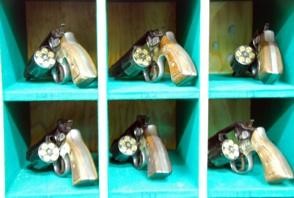
García is scrambling to keep the body count down by slowly upgrading the department’s old .38 service revolvers with semi-automatic handguns and assault rifles. New tactical training compensates for some of the arsenal gap.
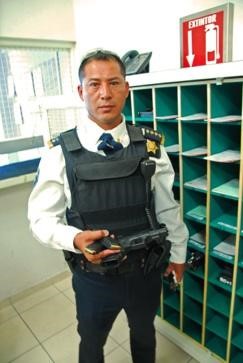
But García recognizes there’s another way to protect his cops: cooperation between governments at their common border. He doesn’t see it happening from his perch.
“I know that international agreements exist,” he said. “What is not going right is the communication. As a representative of the police force in this municipality, I must ask the appropriate national authorities to perform the coordination.”
One consequence of the imperfect alliance between Mexico and the U.S. is that whoever bought the guns from Alvarez and got them to Aguascalientes is presumably still operating.
Laying blame
In the shadow of Aguascalientes’ famous natural landmark called Dead Man’s Mountain, a row of graves in the public cemetery keeps growing. The four Black Thursday victims are buried there under chalk-white tombstones and next to one officer assassinated two months earlier and three more since then. There’s room for more.
Angélica Calderón Nuñez, the widow of Rincón and mother of Angélica and his two other children, approached his tombstone one day earlier this month and tenderly rearranged a fallen plastic flower arrangement. She stood silently over the grave for several moments, tears leaving wet tracks down her face.
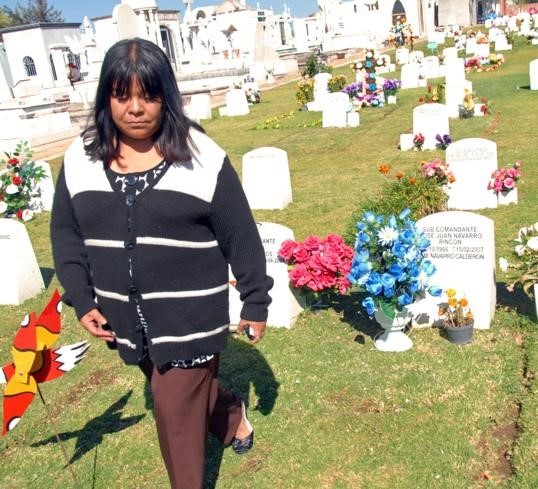
Then she crossed herself, turned and walked away. For Angélica and the other widows, the consequences of losing husbands, fathers and breadwinners have not subsided. The financial settlements, along with posthumous department medals that all four families received, did little to alleviate the pain and psychological trauma for them and their children.
“Life hasn’t been the same. Things changed completely,” Angélica said. “You don’t feel like doing anything. You’re not interested in anything. There’s no drive for life. My children ask a lot for their father. They miss him. They want to hug him.”
Angélica knows the guns that killed her husband probably came from America, but she doesn’t know who to blame: the thugs who used them, the dealers who sell them, or the authorities that can’t seem to stop the smugglers.
“We all know they come from there,” she said, referring to America. “I just can’t explain why they keep coming in.”
Staff writer Sean Mattson and staff photographer Jerry Lara contributed to this report.